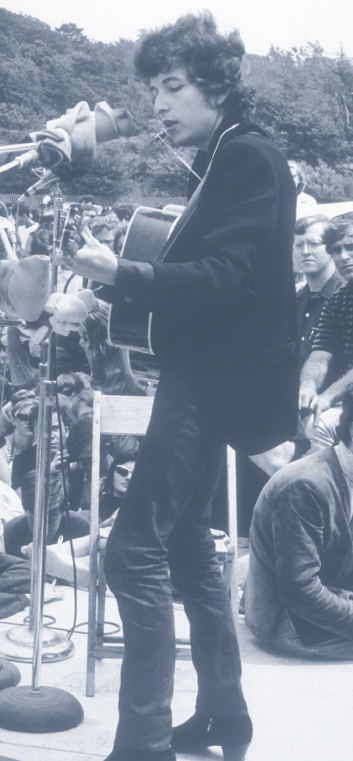Folk and Psychedelic: Protest and Drugs
Printed Page 144
Popular music has always been both a product of and a shaper of its time. So it’s not surprising that the social upheavals of the 1960s and early 1970s—over Civil Rights, women’s rights, environmental protection, the Vietnam War, and the use of recreational drugs—found their reflections in rock music during these decades. By the late 1960s, many songwriters and performers spoke to their generation’s social and political concerns through two music genres: folk and psychedelic rock.

Folk Inspires Protest
The musical genre that most clearly expressed pivotal political events of the time was folk, which had long served as a voice for social activism. Folk music exists in all cultures; it’s usually performed by untrained musicians and passed down mainly through oral traditions. With its rough edges and amateur quality, folk is considered a democratic and participatory musical form. During the 1930s, the work of Woody Guthrie (“This Land Is Your Land”) set a new standard for American folk music. Later, in the 1960s and 1970s, groups such as the Weavers, featuring labor activist and songwriter Pete Seeger, carried on Guthrie’s legacy. These newer groups inspired yet another crop of singer-songwriters—Joan Baez; Arlo Guthrie; Peter, Paul, and Mary; Phil Ochs; Bob Dylan—who took a stand against worrisome developments of the day, including industrialization, poverty, racism, and war.
Rock Turns Psychedelic
With the increasing use of recreational drugs by young people and the availability of LSD (not illegal until the mid-1960s), more and more rock musicians experimented with and sang about drugs during rock’s psychedelic era. Defining groups and performers of this era included newcomers like Jefferson Airplane, Big Brother and the Holding Company (featuring Janis Joplin), the Jimi Hendrix Experience, the Doors, and the Grateful Dead, as well as established artists like the Beatles and the Rolling Stones. These musicians believed they could enhance their artistic prowess by taking mind-altering drugs. They also saw drug-taking as a form of personal expression and an appropriate response to the government’s failure to deal with social and political problems such as racism and America’s involvement in the Vietnam War.
After a surge of optimism that culminated in the historic Woodstock concert in August 1969, the sun set on the psychedelic era. In particular, some of psychedelic rock’s greatest stars died from drug overdoses, including Janis Joplin, Jimi Hendrix, and Jim Morrison of the Doors.